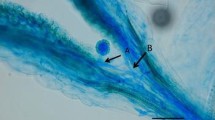Summary
Pollen grains of Streptocarpus wendlandii were irradiated with 5kr and applied to the stigma of untreated plants. In the first generation deficiencies of growth character were frequent. Besides that a great number of the plants was lacking of 1–3 chromosomes. The resulting chromosomal variations have been compared with corresponding variations found in previous experiments with Str. rexii. It has been found, e.g., that as a result of the X-irradiation the number of chromosomes will be reduced in Str. rexii more than in Str. wendlandii. In other respects both species behave much the same, as contrasted with Str. rexii, which is known to possess a cytoplasm diferent from that of Str. wendlandii (Oehlkers, 1938), Str. wendlandii produced only few pollensteriles in X1. On the other hand, in X2 numerous mutations arose in Str. wendlandii, but not in Str. rexii. At least four of them seem to have been present within the genotype of Str. wendlandii still before treatment, as they arose repeatedly in different X2-progenies. These mutations must have been suppressed by an unknown plasmatic or chromosomal factor, and the suppression was released after radiation. Three of these mutations controle morphological features, another one may be designed as “feminization-factor”, because anthers, corolla and calix of the flower are reduced to green rudimentaly leaves carrying ovula at their margins.
In these flowers petals can be open and flat or incurved. A fertilization is only possible with the central pistill. During seed development the ovary will increase in size but it does no more twist.
Thus it was evident that this factor compatible with both the rexii- and the wendlandii-cytoplasm. Two more mutations arose after crossing with Str. rexii, even in both directions: calycanthemy and kleistogamy. The latter was found within all X6-progenies without an exception, in spite of that it never had been found before crossing. Untill now it remained unknown why the character never was manifest. The feminization-character, which was induced by X-rays, is not indentical with the former known character called “super-female”, which appears after crossing Str. wendlandii x rexii, and which is due to an interaction between the cytoplasm of Str. wendlandii and the chromosomes of Str. rexii.
Similar content being viewed by others
Literatur
Gottschalk, W.: Die Wirkung mutierter Gene auf die Morphologie und Funktion pflanzlicher Organe, dargestelt an strahleninduzierten Mutanten von Pisum sativum. Bot. Studien, H. 14 (1964).
Hartmann, M.: Die Sexualität. Jena 1943.
Muller, H.J.: Inbreeding versus “accumulation of blood”. Defense of the genetical concept of inbreeding attacked by Baachuus-Jessen. J. Hered. 17, No 7 (1926).
—: Artificial transmutation of the gene. Science 66, 84–87 (1927).
Muller, H.J.: The problem of genic modification. Suppl. 1, Z. indukt. Abstamm.-u. Vererb.-L. 234–260 (1928).
—: Some genetic aspects of sex. Amer. Naturalist 66, 118–138 (1932).
—: Present-day problems in radiology. IV. Potential hazards of radiation. Excerpta med. (Amst.), Sect. XIV 11, 527–530 (1957).
Muller, H.J.: Radiation and heredity. Mer. J. Publ. Health, January Suppl. 1964.
Oehlkers, F.: Bastardierungsversuche in der Gattung Streptocarpus Lindl. I. Plasmatische Vererbung und die Geschlechtsbestimmung von Zwitterpflanzen. Z. Bot. 32, 154–182 (1938)
—: Bastardierungsversuche in der Gattung Streptocarpus Lindl. III. Neue Ergebnisse über die Genetik von Wuchsgestalt und Geschlechtsbestimmung. Ber. dtsch. bot. Ges. 58, 76–91 (1940).
—: Zytologische und zytogenetische Unterschungen an Streptocarpus. Z. Bot. 39, 113–153 (1944).
—: Blattstecklinge als Indikatoren für blütenbildende Substanzen. Z. Naturforsch. 10b, 158–160 (1955).
Stubbe, H.: Untersuchugen über experimentelle Auslösung von Mutationen bei Antirrhinum majus. I. (Versuche mit Röntgenstrahlen, ultraviolettem Licht, Temperaturschocks und Zentrifugierungen). Z. indukt. Abstamm. u. Vererb.-L. 56, 1–38 (1930).
—: Untersuchungen über die experimentelle Auslösung von Mutationen bei Antirrhinum majus. II. (Samen- und Keimlingsbehandlung mit Röntgenstrahlen und Chemikalien). Z. indukt. Abstamm.-u. Vererb.-L. 56, 202–232 (1930).
—: Untersuchungen über experimentelle Auslösung von Mutationen bei Antirrhinum majus. III. (Die Erhöhung der Gen-Mutationsrate nach Röntgenbestrahlung, Bestrahlung mit ultraviolettem Licht, Temperaturschocks, nebst einigen Bemerkungen über die in diesen Versuchen induzierten Variationen). Z. indukt. Abstamm.-u. Vererb.-L. 60, 474–513 (1932).
—: Untersuchungen über experimentelle Auslösung von Mutationen bei Antirrhinum majus. IV. (Über die Beziehung zwischen Dosis und Genmutationsrate nach Röntgenbestrahlung männlicher Gonen). Z. indukt. Abstamm. u. Vererb.-L. 64, 181–204 (1933).
Author information
Authors and Affiliations
Rights and permissions
About this article
Cite this article
Oehlkers, F. Röntgenversuche mit Streptocarpus wendlandii . Molec. Gen. Genetics 101, 140–154 (1968). https://doi.org/10.1007/BF00336580
Received:
Issue Date:
DOI: https://doi.org/10.1007/BF00336580



